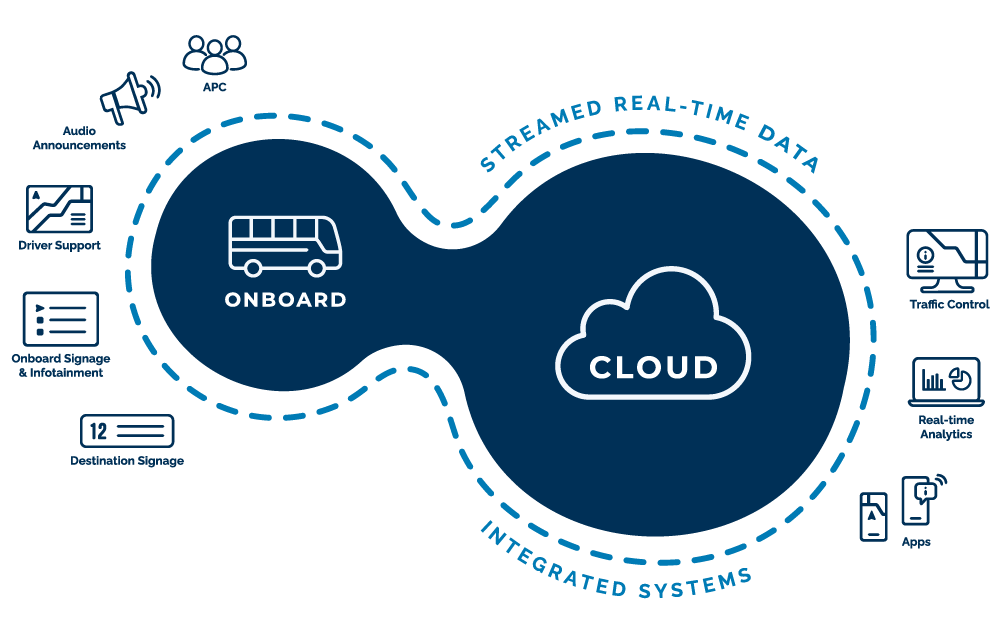Transit Intelligence
Your ecosystem for smarter operations & reliable public transport
To deliver reliable, accessible, and responsive public transport, you need full control over what’s happening across vehicles, systems, and passenger communication. Axentia Transit Intelligence is built for that purpose: a complete, cloud-native ecosystem that helps Public Transport Authorities manage complexity, adapt to change, and keep passengers informed. Share one source of truth across your organization, your vehicles, and your travelers.

One system for everyone involved in public transport
For Public Transport Authorities
Enhance the passenger experience by managing your trips centrally, measuring the quality of your services and implementing new intelligent functionality as the world develops.
For Operators
Control all your vehicle technology with ease, regardless of the hardware onboard. One software solution that scales effortlessly and manages your real-time operations.
For Passengers
Ensure a positive travel experience for passengers by providing true real-time information at all times. Make public transport reliable and accessible for everyone – even when conditions change.
Transit Intelligence Cloud Platform
Your central intelligence for real-time control
The Cloud Platform is the core of Transit Intelligence, providing real-time control, flexibility, and future-readiness. It connects your systems, vehicles, and users through one single platform, enabling full real-time control over traffic operations, from service adjustments and disruption handling to passenger communication and performance monitoring.
Built on real-time digital twins, continuous data flows, and automated logic, the Cloud Platform helps Public Transport Authorities stay one step ahead. It enables fast, data-driven decisions, consistent communication across all channels, and smart adaptation to changes – all while supporting future mobility and evolving needs through an open, scalable platform.
Features:
- Central Traffic Control
- Real-time Traffic Visualization
- Performance Monitoring
- Deviation & Disruption Management
- Service Adjustments
- Traffic & Passenger Information
- AI Agents
Transit Intelligence highlights
One cloud platform
Monitor and manage your entire fleet in one place. Share one source of truth across your organization to coordinate traffic modes, manage services, respond to disruptions, and deliver consistent information across all channels.
Seamless integration
Designed to integrate easily with existing traffic systems and open data sources. Supporting standards like GTFS, NeTEx, SIRI, and NOPTIS. It enables systems to function together and enhances the value of previous investments.
AI & real-time analytics
Use AI-driven logic, dynamic digital twins, and real-time traffic data to get insights, automate decisions, respond to disruptions, and continuously improve service quality.
Scalable & future-proof
Handle the increasing data volumes of modern public transport with a scalable, cloud-native architecture – ready for new mobility needs and technologies.
Low barrier to get started
Get started quickly with a flexible platform that requires minimal investment while unlocking immediate benefits in operations, service quality, and passenger communication.
Transit Intelligence Onboard Platform
Connect your vehicles for better travel experiences
The Onboard platform is the vehicle-side software in Transit Intelligence, ensuring accurate, real-time information before and during trips. It connects vehicles to the cloud and operates online-first. The platform collects real-time vehicle data, facilitates passenger communication, provides onboard system insights, and simplifies the digital landscape for drivers. It is built to work with mixed hardware across generations and open standards, ensuring compatibility, uptime, and full control over onboard systems, even in temporary or replacement buses.
Features:
- Real-time Passenger Information System
- Infotainment
- APC
- Driver Support
- Remote Device Monitoring and OTA software updates

Key Benefits of the Onboard Platform:
- One software for all onboard hardware
Run a unified system across mixed fleets, allowing various hardware and generations to function together. Avoid technological limitations and ensure long-term flexibility.
- Reduce manual workload and minimize downtime
Monitor onboard devices in real-time and deploy over-the-air updates to minimize downtime, reduce manual work, detect issues early, and ensure reliable information onboard vehicles.
- Ensure reliable, accessible travel
Provide reliable real-time information to all passengers, including personalized tools for travelers with special needs. Ensure public transport is safe, dependable, and accessible for everyone.
- Powerful tools for drivers
Provide a centralized, intuitive interface that reduces complexity for drivers and supports efficient day-to-day operations.
- Always connected & built for real-time
The onboard system stays in sync with your central platform in real-time. Its online-first design and offline recovery ensure reliable performance and accurate information, even with connectivity issues.

Transit Intelligence Analytics
To deliver the best possible public transport, we must observe and understand traffic while measuring the quality of our information and punctuality. Analytics turns your operational data into clear insights, helping you understand performance, identify issues, and improve your public transport services in real-time. With live dashboards and historical trends, you can monitor punctuality, passenger occupancy, disruptions, and system status across your entire fleet. It provides immediate access to crucial information.
Features:
- Live vehicle positions and on-time performance
- Passenger load and occupancy monitoring
- Disruption and reroute tracking
- System and device health reporting
- Historical trip data and performance trends
Benefits of Transit Intelligence Analytics:
- Live & historical performance insights
Monitor punctuality, vehicle locations, passenger loads, and onboard system status in real-time.
- Understand trends & improve services
Turn real-time data into clear insights to drive better planning and decisions.
- Measure and improve service quality
Track performance, identify issues, and validate your traffic and passenger information.

CMS (Content Management System)
Manage your content & engage your passengers
Axentia CMS gives you full control over the content shown on your public transport displays, both at stops and in vehicles. Whether it’s service messages, real-time information, or infotainment, the system lets you manage and schedule what passengers see, where, and when.
Features:
- Support for different screen types and sizes
- Media management for images and videos
- Playlist creation combining media and real-time information
- Layout and schedule planning by time and location
- Assign content to specific displays or entire display groups
Benefits of Axentia CMS:
- Full control of all your displays
Manage content on stations, bus stops and onboard vehicles from one central interface.
- Target content by time and location
Schedule layouts and playlists to match routes, areas, or time of day.
- Combine real-time data with engaging media
Easily mix service messages, infotainment, images, and videos for dynamic content delivery.
Customer Case

Östgötatrafiken, Sweden
With Transit Intelligence, Östgötatrafiken replaced outdated onboard systems, gaining full control over operations and real-time passenger information. They improved service reliability and consistent, accurate communication with passengers and drivers across the entire fleet.